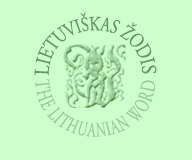- It is estimated that at the^end of the
16th century 20% of the inhabitants of Konigsberg were Lithuanians.
There is a
- scarcity of earlier information,
but it is known that in 1531 Lithuanian Protestant services were being
held in the hospital church. The first minister was John
Tortilavicius, who had been the pastor of the Silale parish in
Lithuania. Subsequent pastors of the Lithuanian Protestant parish in
Konigsberg were Bartholomew Vilentas, a religious writer, from 1550-1587,
John Bretkūnas, the first translator of the Bible into Lithuanian,
from 1587-1602, and others. At the beginning of the 17th century the
Jesuits established a Catholic mission, to which one or two Lithuanian
priests were regularly assigned. Serving in the mission from 1651-1655
was the Jesuit John Juknevičius, whose Lithuanian sermons drew large
crowds of listeners. Other Jesuits continued to deliver sermons in the
Lithuanian language until the first quarter of the 18th century. After
the Great Plague of 1709-1711 the Jesuit mission ceased its work, and
the number of Lithuanian-speaking inhabitants began to decrease. The
official census of 1860 listed only 469 Lithuanians in Konigsberg.
Nevertheless, Lithuanian Protestant services continued to be held
until after World War I.
- The first Lithuanian book, the Catechism
of Martynas Mažvydas (q.v.), was published in Konigsberg in 1547 by
the Hans Weinreich press. It was later followed by a number of
religious books, hymnals, dictionaries, collections of songs, and
literary works. In 1833 Konigsberg became the home of the first
Lithuanian periodical, Nusidavimai apie Evangelijos Prasiplatinimą
(News about the Propagation of the Gospel), edited by Frederick Kelkis
(the newspaper -had its beginnings in Klaipeda and Tilžė in 1832).
Keleivis (The Traveler), another Lithuanian newspaper, began to be
published in 1849. During the 18th century various books in the German
language dealing with Lithuania Minor, its inhabitants, traditions,
folklore, and the Lithuanian language began to appear in the
publishing houses of Konigsberg.
- The printing of Lithuanian works
was encouraged by Duke Albrecht of Prussia (1525-1568). In 1541 he
founded a school of higher academic learning called the Paedagogium
or Particular. The school's first director was Abraham
Kulvietis of Vilnius. In 1544 the school began to function as an
university with 11 professors and 200 students. Abraham Kulvietis
became the first professor of the Greek and the Hebrew languages,
while Stanislas Rapolionis, another Lithuanian, headed the
university's most important chair, that of theology. Duke Albrecht
provided several scholarships for Lithuanian students who were
preparing for the ministry in the parishes of Lithuania Minor (East
Prussia) and Lithuania Major. At the university from 1544-46 there
were 23 students from Lithuania Major alone; in 1744 there were 62.
Among them there were many who later distinguished themselves as
Lithuanian educators and writers, such as Mažvydas, Bretkūnas,
Kleinas, Rugys, Vaisnoras, Donelaitis, and others. Also to be
mentioned among those who studied at the university and later engaged
in scholarly research are Ludwig Rhesa (Rėza), professor at the
university from 1807, and Friedrich Kurschat (Kuršaitis), director of
the Lithuanian Seminar from 1841. The Seminar for the study of the
Lithuanian language was established in 1718 and existed for more than
a century. It was attended not only by Lithuanians, but also by
Germans who wished to work in Lithuanian parishes and schools and thus
required a knowledge of the language. In 1727 the seminar was attended
by 30 students. There were Lithuanians studying at the University of
Konigsberg until World War II.
-
Text from the ENCYCLOPEDIA
LITUANICA I-VI. Boston, 1970-1978

